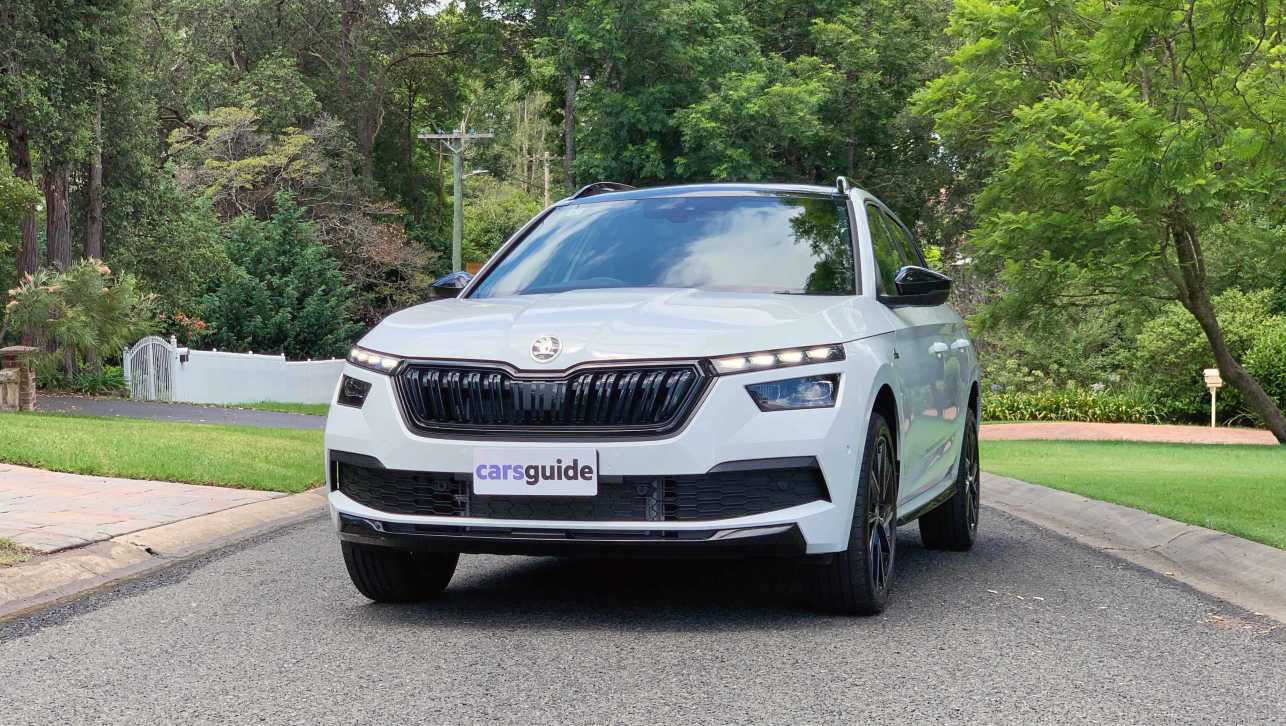The Skoda Kamiq has impressed us since its launch. It won our recent light SUV comparison test, though the version of the Kamiq that beat the Toyota Yaris Cross and Ford Puma in that review was rather different to the one you see here.
That’s because this one is the Monte Carlo. Those familiar with Skoda’s history will know that means it gets a number of sportier finishes inside and out, and is not to be confused with the very tea-dippable Aussie bikkie.
But for the 2021 Kamiq Monte Carlo, there’s more to the recipe than just a sportier look. Instead of just a sprinkle of visual flavour - like we’ve seen with the Fabia Monte Carlo in the past - the Kamiq Monte Carlo whets the appetite with a bigger, more powerful engine.
In fact it gets the same powertrain as the just launched Scala hatchback, but in a more diminutive package. But with the base model Kamiq arguing a supreme case on value for money, does this new, more expensive variant make as much sense as the base model?
Skoda Kamiq 2021: 110TSI Monte Carlo
| Safety Rating |
|
|---|---|
| Engine Type | Turbo 4, 1.5L |
| Fuel Type | Premium Unleaded Petrol |
| Fuel Efficiency | 5.6L/100km (combined) |
| Seating | 5 |
| Price From | $30,360 - $36,630 |
Does it represent good value for the price? What features does it come with?
8 / 10
The 2021 Skoda Kamiq 110TSI Monte Carlo isn’t a cheap small SUV. The company has a list price for this variant of $34,190 MSRP (that’s before on-road costs), but it has also launched the model with a national drive-away price of $36,990, no more to pay.
That isn’t what you’d call wallet-friendly for a car of this size - though one must remind oneself that the top-spec Hyundai Kona in front-wheel drive is a $38,000 proposition, before on-road costs! - and, comparatively, the Kamiq Monte Carlo is exceedingly well equipped for the money.
Standard equipment for this 110TSI version of the Kamiq includes 18-inch Vega black alloy wheels, an electric tailgate, LED rear lighting with dynamic indicators, LED headlights with adaptive beam and animated turn signals, fog lights, tinted privacy glass, an 8.0-inch touchscreen media system with Apple CarPlay and Android Auto smartphone mirroring, wireless phone charging, and a neat 10.25-inch digital instrument display.
.jpg)
There are four USB-C ports (two up front and two more in the rear for charging), a covered centre armrest, leather steering wheel, Monte Carlo cloth-trimmed sports seats, manual seat adjustment, a space saver spare wheel and tyre pressure monitoring, a reversible cargo liner, push-button start, proximity keyless entry, and dual-zone climate control.
There’s a pretty strong safety story to be told, too - but you’ll have to read the safety section below for more detail.
The Monte Carlo also nabs a bunch of aesthetic changes over the base model. Aside from different 18-inch rims, there’s exterior design black pack, a panoramic glass roof (not an actual opening sunroof), and the brand’s Sport Chassis Control setup - it’s lowered 15mm and has adaptive suspension and a few drive modes. It has a black headliner inside, too.
.jpg)
If you still think you need more spec for your spend, there’s a Travel Pack available for the Kamiq Monte Carlo. It costs $4300 and swaps in a larger 9.2-inch media screen with sat nav and wireless CarPlay, as well as including semi-autonomous parking, blind spot and rear cross-traffic alert, heated front and rear seats (with cloth trim), and scores paddle shifters.
Colour options for the Monte Carlo include optional ($550) metallic finishes in Moon White, Brilliant Silver, Quartz Grey, Race Blue, Magic Black, while the eye-catching Velvet Red premium paint costs $1110. Don’t want to pay for paint? Your only no cost option is Steel Grey for the Monte Carlo.
Is there anything interesting about its design?
8 / 10
Not quite the conventional SUV look, is it? No black plastic cladding around the bumpers or the wheel arches, and less of a high-riding hatchback than most.
Indeed, the Kamiq Monte Carlo is a lower-riding version than the standard, thanks to its 15mm lowered sport suspension. And it gets flashy 18-inch wheels with black finishes, whereas the standard Kamiq still rides atop 18s.
But there are other styling differentiators that those who are familiar with the Monte Carlo theme will expect, such as black exterior styling elements - black window surrounds rather than chrome, black lettering and badges, black mirror caps, black roof rails, a black grille frame. That all adds to its more aggressive look, while the panoramic glass roof (not an opening sunroof), sports seats and sports pedals make it feel more, well, sporty.
Is it as eye-catching as a Ford Puma ST-Line, or a Mazda CX-30 Astina, or any other small SUV that stands out for style? You'll have to be the judge of that, but to my eye, it’s an interesting, if not conventionally gobsmacking, small SUV. I couldn’t un-see the rear-end similarities to a first-generation BMW X1, though… and now you may not be able to, either.
.jpg)
It plays in the “Small SUV” segment based on official sales results and you can see why when considering its dimensions. The Kamiq is just 4241mm long (on a 2651mm wheelbase), and it’s 1793mm wide and 1531mm tall. For context, that makes it smaller than a Mazda CX-30, Toyota C-HR, Subaru XV, Mitsubishi ASX and Kia Seltos, and not far off its cousin, the VW T-Roc.
Unlike many SUVs in this segment, the Kamiq features the thoughtful inclusion of an electric boot lid, which you can open using the key, too. Plus there’s a surprisingly large boot capacity - check out the interior images below.
How practical is the space inside?
9 / 10
The interior of the Kamiq Monte Carlo is decidedly sportier than the lower grade version.
It’s more than just the interesting fabric finish on the sports seats and the red stitching in the cabin. It’s also the natural light that is let in by the enormous panoramic glass roof – just remember this isn’t a proper sunroof, so you can’t open it. And while that does add some hotness to the cabin in terms of appeal, it also adds some actual heat to the cabin because it’s a huge glass roof. In summer in Australia, that mightn’t be ideal.
But the glass roof is an eye-catching element to what is also a pretty fetching interior design. There are lovely items including the aforementioned standard digital dashboard for the driver which stands apart from plenty of its rivals with part-digital info clusters, and also the general look and feel and quality materials that have been used inside the cabin is of a pretty high standard.
Some people might moan a little about the harder cheaper plastics on some parts of the cabin – like the door grabs and some parts of the door trims, and also the lower dashboard components, but the dash top, elbow padding and the tops of the doors are all soft material and they feel nice to the touch.
There’s also a decent amount of storage – it is a Skoda after all!
Between the seats there are cupholders, although they are a little shallow so just be careful if you have a tall very hot coffee. In the front doors there are large trenches with bottle holders as well. There is a storage cutaway in front of the gear selector, which incorporates a wireless phone charger, and also two USB-C ports. And the glovebox is a decent size, and there’s an additional small storage box on the driver’s side to the right of the steering wheel.
.jpg)
The seats are extremely comfortable, and while they are manually adjustable and not leather trimmed, they are very well suited to this application.
Most of the ergonomics are on-point as well. The controls are easy to find an easy to get used to, however I’m not a massive fan of the fact that there is no fan control button or dial on the climate control switch bank. To adjust the fan you either have to do so through the media screen, or have the climate control set to 'auto' which chooses the fan speed for you. I prefer to set the fan velocity myself, but the 'auto' system has been fine during my test.
On the media screen front, I also don’t like that there are no knobs or hard buttons down the side of the optional 9.2 inch screen fitted to the test vehicle. However it is something you do get used to, and so are the menus and controls for the multimedia screen. And the 8.0-inch screen in the non-optioned car gets the old-school dials.
.jpg)
In a few previous VW and Skoda models with wireless CarPlay I had issues connecting properly and quickly. This car was no exception – it took a little while for it to figure out that I wanted this phone to be connected wirelessly, however it maintained a pretty stable connection over the period of my test.
In the backseat things are exceptionally good. Behind my own driving position - I'm 182cm or 6'0" tall - and I can comfortably sit with inches of knee and leg room, as well as generous toe space. Headroom is also good for tall occupants even with the sunroof taken into consideration, and while the rear seat isn’t as bolstered or well sculpted as the fronts, it is comfortable enough for adults.
If you have children there are two ISOFIX points on the outboard seats, and three top to the points across the back row. Kids will be happy with the directional air vents, 2x USB-C ports, and there are pockets on the seat backs as well, not to mention big door cubbies with bottle holders. However there is no fold-down armrest nor any cupholders.
.jpg)
The seats can be folded almost flat, in a 60:40 split. And the boot space cargo capacity with the seats up – at 400L – is superb for this class of car, especially given its exterior dimensions. We manage to fit all three of our suitcases – 124L, 95L, 36L – in the boot with room to spare. Plus there’s the usual array of hooks and nets that we’ve come to expect from Skoda, and a space saver spare wheel under the boot floor. And yes, there is an umbrella hidden in the driver’s door, and an ice scraper in the fuel filler cap, and that’s where you find the recommended tyre pressures as well.
What are the key stats for the engine and transmission?
8 / 10
Unlike the entry grade three-cylinder Kamiq, the Kamiq Monte Carlo model scores a four-cylinder turbo engine with a few more bees under the bonnet.
The Kamiq’s 1.5-litre 110TSI engine produces 110kW of power (at 6000rpm) and 250Nm of torque (from 1500-3500rpm). Those are pretty decent outputs for the class, and a sizeable step up from the 85kW/200Nm of the base model. Like, it’s 30 per cent more power and 25 per cent more torque.
The 110TSI only comes teamed with a seven-speed dual-clutch automatic transmission, and the Kamiq is exclusively a 2WD option (front-wheel drive), so if you need AWD/4WD (all-wheel drive) you might be best to step up to the Karoq Sportline, which will cost you about $7000 more - but it’s a bigger more practical car without being oversized, and it’s a lot more powerful, too.
How much fuel does it consume?
8 / 10
For the Skoda Kamiq Monte Carlo model the claimed combined cycle fuel consumption is just 5.6 litres per 100 kilometres. That’s what the manufacturer claims should be possible across a mix of driving.
To help it achieve that theoretical number, the 110TSI version of the Kamiq has engine start-stop technology (cuts the motor when you’re at a standstill), as well as the potential to use cylinder deactivation and run on two cylinders under light load.
.jpg)
Our test loop comprised urban, highway, country and freeway testing - the Scala returned an at-the-pump fuel consumption figure of 6.9L/100km.
The Kamiq has a 50 litre fuel tank capacity, and it requires 95RON premium unleaded.
Warranty & Safety Rating
What safety equipment is fitted? What safety rating?
8 / 10
The Skoda Kamiq was awarded a five-star ANCAP crash test rating against the authority’s 2019 scoring criteria. Yep, you bet the rules have changed since then, but the Kamiq is still well sorted for safety equipment.
All versions are fitted with autonomous emergency braking (AEB) that works from 4km/h to 250km/h. There is also pedestrian and cyclist detection as part of that, operable from 10km/h to 50km/h, and all Kamiq models come standard with lane departure warning and lane keeping assistance (works from 60km/h to 250km/h), plus driver fatigue detection.
We don’t love that blind-spot monitoring and rear cross-traffic alert are still optional at this price point, as some rivals thousands of dollars cheaper have that tech. If you option the Travel Pack with blind-spot and rear cross-traffic you also get the semi-autonomous parking system, which includes the addition of front parking sensors. Standard you get a reversing camera and rear parking sensors, plus Skoda fits a standard rear auto braking system known as “Rear Manoeuvre braking assist” that should prevent low-speed car park bingles.
Kamiq models come with seven airbags - dual front, front side, full-length curtain and driver’s knee protection.
What does it cost to own? What warranty is offered?
8 / 10
You might have thought about buying a Skoda in the past, but been unsure about the potential ownership prospects. However, with recent changes to the company’s ownership approach, those doubts may well have been addressed.
In Australia Skoda offers a five-year/unlimited kilometre warranty, which is par for the course amongst mainstream rivals. Roadside assistance is included for the first year of ownership, but if you maintain your car with Skoda’s workshop network it extends annually, out to a maximum of 10 years.
Speaking of servicing - there’s a capped price program spanning out to six years/90,000km, with an average cost per service (maintenance intervals every 12 months or 15,000km) of $443.
However, there’s an even better deal on the table.
If you choose to prepay your servicing costs with one of the brand’s Service Packs, you’ll be saving heaps. Choose three years/45,000km ($800 - would otherwise cost $1139) or five years/75,000km ($1200 - would otherwise be $2201). The added benefit is if you roll that upfront cost into your finance payments, it’s one less thing to budget for annually.
If you know you’re going to do lots of kilometres - and based on some of the used car listings out there, plenty of Skoda drivers do! - there’s one more service option you might want to consider. Skoda has rolled out a subscription plan for maintenance, which includes your servicing, all the consumables, and other items like brakes, brake pads and even tyres and wiper blades. Prices start at $99 a month depending on how much mileage coverage you need, but there’s a half-price promo deal to launch the Kamiq.
What's it like to drive?
8 / 10
The Skoda Kamiq impressed us with its general abilities inour recent comparison test, and the drive experience in the Kamiq Monte Carlo is also a pretty impressive serve from the brand.
It comes down to the engine, which - obviously, with more capacity, power, and torque - is a livelier experience, and helps justify the big jump in asking price… to a degree.
Don’t get me wrong. This is a good little engine. It offers strong power and torque, and feels more zesty - especially in the mid-range - than the entry-level three-cylinder unit.
Personally, I’d be sure to test drive the two back to back, because I reckon the three-pot could actually be the sweet spot for a lot of customers out there who aren’t going to explore the potential of this powertrain.
.jpg)
For the more enthusiastic driver, the 110TSI hits some obvious and expected highs. It pulls the lightweight (1237kg) Kamiq along without hassle, and the acceleration is better as a result (the claimed 0-100km/h time for the 110TSI is 8.4 seconds, whereas the 85TSI with the DSG is pegged at 10.0sec). That is hardly a speed demon 0-100 time, but it is speedy enough.
However, in boring commuter driving and stop-start traffic, or just when you’re pulling out of a parking spot or intersection, the transmission can be hard to cope with. In combination with some low-rev lag, the engine’s start-stop system and a bit of a twitchy throttle, taking away from a standing start can require more thought and consideration than it really ought to. Be sure to get stuck in traffic or at intersections on your test drive.
The real star of the show is the way this car handles itself.
The Monte Carlo gets the lowered (15mm) chassis setup, which incorporates adaptive dampers as part of the suspension setup. What that means is that the ride comfort can be, well, very comfortable in Normal mode, but the suspension characteristics change when you put it in Sport mode, stiffening up and feeling more hot-hatch-like.
The drive modes affect the steering weight, suspension and the powertrain performance, too, freeing up better throttle response and also allowing more aggressive gear shifts while allowing the transmission to explore the rev range.
.jpg)
The steering is pretty excellent no matter the mode, offering great precision and predictability. It’s not so quick as to make direction changes hurt your neck, but it does pivot very well in tight bends, and you can feel the Volkswagen Group roots under the metalwork in the way it behaves on the road.
Look, you aren't getting Golf GTI genes here. It’s still very fun and certainly exciting enough for its intended audience, but there is some torque steer under hard acceleration - that’s where the steering wheel can tug to either side as you throttle it - and some wheel spin, especially in the wet, but also notably in the dry. And while the Eagle F1 tyres are pretty good for a thrash sometimes, don't go expecting race track-ready levels of grip and traction.
There are a few other things we would hope might be improved: the road noise is excessive on coarse-chip roads, so a bit more sound deadening wouldn’t go astray; and the paddle-shifters should be standard on all Monte Carlo models, not as part of a pack.
Otherwise, this is an extremely competent and fun small SUV.
Verdict
The Skoda Kamiq Monte Carlo is a very competent and nicely packaged small SUV. It has the smarts we’ve come to expect from Skoda, and because this second-grade-up-the-range model has the bigger, more powerful engine and the sportier driving dynamics of that chassis setup, the Monte Carlo will appeal to those who want not only a cooler look, but also hotter performance.
Now, then, there are two different takes on the Kamiq for two different types of buyers. Seems like a logical approach to me.
Pricing Guides

Range and Specs
| Vehicle | Specs | Price* |
|---|---|---|
| 85TSI | 1.0L, Premium Unleaded Petrol, 6 SPEED MANUAL | $21,340 - $27,060 |
| 85TSI | 1.0L, Premium Unleaded Petrol, 7 SPEED AUTO DIRECT SHIFT | $22,770 - $28,050 |
| Ambition | 1.5L, Premium Unleaded Petrol, 6 SPEED MANUAL | $28,820 - $34,760 |



.jpg)
.jpg)
.jpg)
.jpg)
.jpg)
.jpg)
.jpg)
.jpg)
.jpg)
.jpg)
.jpg)
.jpg)
.jpg)
.jpg)

.jpg)
.jpg)
.jpg)
.jpg)









































 copy.png)













.png)

.jpg)

.jpg)
jpg.jpg)

.jpg)

.jpg)
.jpg)

Comments